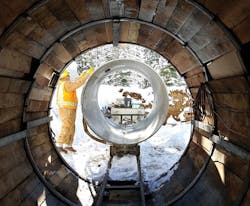| Manufactured in ten-foot sections, lightweight CCFRPM was easier to maneuver on the narrow job site. |
The Michigan Ditch is a combination of open waterway and pipelines. “Approximately 1,600 feet of the ditch still runs through the original wood stave pipe material, some of it exposed and still above grade,” said John Beckos, project manager with BT Construction Inc. of Henderson, Colo. “The Michigan Ditch Rehabilitation Project replaced a combination of open ditch and buried 54-inch ductile iron pipe through the section of the ditch known as ‘The Mudslide’.”
In 2015, movement of an ongoing slow-moving landslide that began years ago became so extreme that it changed the alignment of the pipe to an extent it could not be repaired with a cut and cover solution. In order to retain its water rights, Fort Collins Utilities determined that a repair of the collection system was necessary. After considering many options, a tunnel through the mountain was determined to be the best solution.
Field Versatility
A 765-foot-long curved tunnel was bored through the side of the mountain using a tunnel boring machine (TBM). The tunnel has an outside diameter of 96 inches and an initial support of steel rib and wood lagging. Following tunnel construction, 765 feet of 60-inch Hobas pipe was inserted into the primary tunnel to serve as the carrier pipe for the water. The pipe for the tunnel was manufactured with a stiffness class of SN 62, in 10-foot sections, with a flush joint configuration that was blocked into place and subsequently grouted. BT Construction was the installation contractor for the tunnel. Due to soil and ground conditions, the tunnel was designed with a slight curve. “It was determined that a 0.9-degree deflection for every ten-foot joint would match up quite well with the Flush Reline pipe (1.2 degrees max),” said Beckos.






